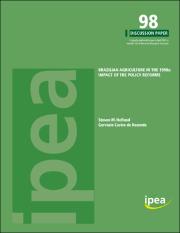Please use this identifier to cite or link to this item:
https://repositorio.ipea.gov.br/handle/11058/4970Full metadata record
| DC Field | Value | Language |
|---|---|---|
| dc.contributor.author | Helfand, Steven M. | - |
| dc.contributor.author | Rezende, Gervásio Castro de | - |
| dc.contributor.other | Berry, Albert (Comentários) | - |
| dc.contributor.other | Araujo, Paulo Fernando Cidade de (Comentários) | - |
| dc.contributor.other | Jarvis, Lovell (Comentários) | - |
| dc.contributor.other | Gasques, José Garcia (Comentários) | - |
| dc.contributor.other | Saddi, Vitoria (Comentários) | - |
| dc.contributor.other | Fazecas, Marcos Stefan Mendonça (Assistência de pesquisa) | - |
| dc.contributor.other | Alan, Levenson (Assistência de pesquisa) | - |
| dc.coverage.spatial | Brasil | pt_BR |
| dc.coverage.temporal | 1990-1999 | pt_BR |
| dc.date.accessioned | 2015-10-29T21:52:19Z | - |
| dc.date.available | 2015-10-29T21:52:19Z | - |
| dc.date.issued | 2015-01 | - |
| dc.identifier.uri | http://repositorio.ipea.gov.br/handle/11058/4970 | - |
| dc.description.abstract | Este trabalho descreve de modo sintético as mudanças de política econômica e de condições macroeconômicas nos anos 90 e analisa o impacto dessas mudanças sobre o setor agrícola. Procura-se enfatizar quatro aspectos que foram ignorados ou que não receberam a atenção devida pelos autores que trataram do assunto no período anterior às reformas. A primeira questão relaciona-se com a importância dos fatores macroeconômicos, sobretudo as políticas de estabilização, para a análise do tema. A segunda questão reside na importância de mudanças em outras políticas que não a mera abertura externa, como a desregulamentação dos mercados domésticos e as mudanças nas políticas de crédito rural e de preços mínimos.Um terceiro aspecto que também não recebeu a devida atenção das análises pré-reforma é o impacto das novas políticas econômicas sobre o mercado de insumos e sobre a produtividade. A quarta e última questão enfatizada neste trabalho é que os efeitos das reformas foram muito diferenciados segundo produtos, regiões ou tipos de agricultores. O trabalho sugere, ainda, que, como nem todas as reformas foram introduzidas simultaneamente, os anos 90 devem ser tratados como uma década de transição em que o velho modelo foi substituído, porém nem todas as etapas do novo modelo foram firmemente estabelecidas. | pt_BR |
| dc.language.iso | en-US | pt_BR |
| dc.publisher | Instituto de Pesquisa Econômica Aplicada (Ipea) | pt_BR |
| dc.title | Brazilian agriculture in the 1990s: impact of the policy reforms | pt_BR |
| dc.title.alternative | Discussion Paper 98 : Brazilian agriculture in the 1990s: impact of the policy reforms | pt_BR |
| dc.title.alternative | A agricultura brasileira na década de 1990: o impacto das reformas políticas | pt_BR |
| dc.type | Discussion Paper | pt_BR |
| dc.rights.holder | Instituto de Pesquisa Econômica Aplicada (Ipea) | pt_BR |
| dc.source.urlsource | http://www.ipea.gov.br | pt_BR |
| dc.location.country | BR | pt_BR |
| dc.description.physical | 39 p. : il. | pt_BR |
| dc.rights.license | Reproduction of this text and the data it contains is allowed as long as the source is cited. Reproductions for commercial purposes are prohibited. | pt_BR |
| dc.subject.keyword | Setor agrícola | pt_BR |
| dc.subject.keyword | Crédito rural | pt_BR |
| dc.subject.keyword | Condições macroeconômicas | pt_BR |
| dc.subject.keyword | Política econômica | pt_BR |
| dc.relation.references | http://repositorio.ipea.gov.br/handle/11058/2329 | pt_BR |
| ipea.description.objective | Descrever as mudanças de política econômica e de condições macroeconômicas nos anos 90, e analisar o impacto dessas mudanças sobre o setor agrícola. | pt_BR |
| ipea.description.additionalinformation | Série monográfica: Texto para Discussão ; 785 | pt_BR |
| ipea.description.additionalinformation | Possui referências bibliográficas | pt_BR |
| ipea.description.additionalinformation | Série: Originally published by Ipea in April 2001 as number 785 of the series Texto para Discussão. | pt_BR |
| ipea.access.type | Acesso Aberto | pt_BR |
| ipea.rights.type | Licença Comum | pt_BR |
| ipea.englishdescription.abstract | This paper describes the changes in economic policies and in macroeconomic conditions in the 1990s and analyses their impact on the agricultural sector in Brazil. We emphasize four aspects of the reform period that were either unexpected or not given sufficient attention by authors writing in the period prior to the reforms. The first issue relates to the importance that events outside of the agricultural sector, specially the stabilization problems, have not only for the performance of the sector but also for the timing and sequence of policy reform. A second issue that we emphasize is that policy reform involved far more than trade liberalization. Deregulation and the reform of rural credit and support price policy have been central as well. A third issue that was not given sufficient attention by the pre-reform analyses that focused on agricultural prices is the impact of policy reform on input markets and productivity. We identify changes in input markets as one of the key components of the adjustment process. A fourth and final issue that we address is that policy reform had a highly differentiated impact on the sector. Reform was neither uniformly beneficial, nor entirely prejudicial. Thus, our analysis seeks to distinguish between different groups of products, such as importables and exportables, geographic regions, farm sizes, and sub-periods. The paper emphasizes also that, since not all reforms were introduced simultaneously, the 1990s should be treated as a decade of transition in which the old model was replaced, but not all of the features of the new model were firmly established. | pt_BR |
| ipea.researchfields | N/A | pt_BR |
| ipea.classification | Agricultura, Pecuária e Pesca | pt_BR |
| Appears in Collections: | Agricultura, Pecuária e Pesca: Livros | |
Files in This Item:
| File | Description | Size | Format | |
|---|---|---|---|---|
| DiscussionPaper_98.pdf | 336.76 kB | Adobe PDF |  View/Open |
Items in DSpace are protected by copyright, with all rights reserved, unless otherwise indicated.

